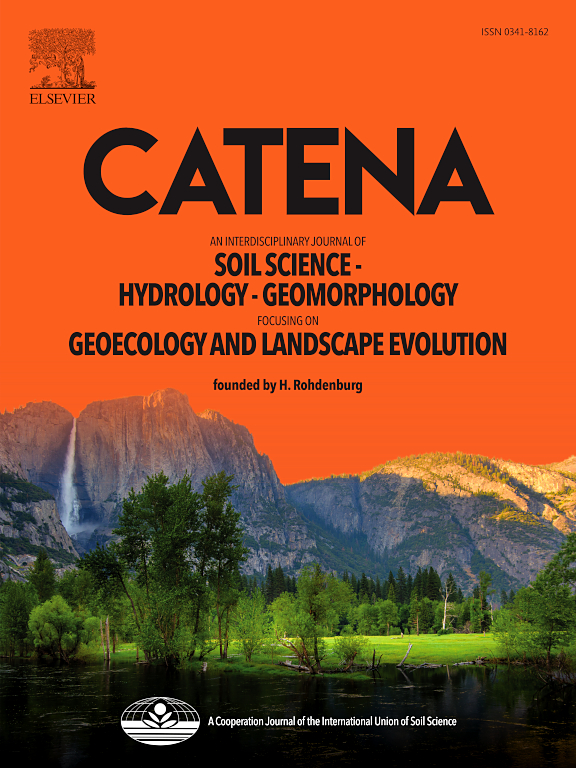Reconstruction of the prehistoric environment on the basis of analyzing the chernozem used for the construction of the Neolithic long barrow at the Dušníky site (Czech Republic)
IF 5.4
1区 农林科学
Q1 GEOSCIENCES, MULTIDISCIPLINARY
引用次数: 0
Abstract
The Neolithic long barrow of Dušníky in Central Bohemia (Czech Republic) was intensively investigated in 2021. The archaeological observations of the site, together with a set of pedological (chemical composition, paleomagnetic properties, near-infrared spectroscopy, radiocarbon dating, and micromorphology) and archaeobotanical analyses (anthracology, and phytoliths) of the soil and related sediment, were used to obtain reliable information about the construction of the barrow and paleoenvironment of the site.
We assume that the barrow was piled up over the grave of a ten-year-old boy. The construction material of the mound is the humic horizon of the surrounding chernozem; the original soil surface under the mound was not affected. Afterwards, a ditch was dug around the barrow. The subsoil sand dug up during this process was intentionally deposited at the foot of the barrow. This sand embankment together with the surrounding chernozem and mound gradually eroded into the ditch. After the ditch was filled, the mound further eroded into the surrounding area. Currently, the site is nearly invisible because it has been destroyed by millennia-long agriculture. The current surviving height of the barrow is appr. 80–100 cm.
We conclude that the site at the moment of the construction of the barrow (3633–3522 cal. BC) was not occupied by Neolithic people, it has only a funerary character. The vegetation at the site at the time of arrival of builders of the barrow was an open woodland dominated by Pinus, with the rare presence of Quercus and Juniperus and the presence of steppe grasses. This study fills the gap in the knowledge of Neolithic populations in central Bohemia. Even if situated in the region of fertile chernozems in Bohemia, the site carries no traces of occupation before the construction of the barrow.

基于对Dušníky遗址新石器时代长墓所用黑钙土分析的史前环境重建(捷克共和国)
2021年,人们对波希米亚中部(捷克共和国)Dušníky的新石器时代长墓进行了深入调查。通过对该遗址的考古观测,以及土壤和相关沉积物的土壤学(化学成分、古地磁特性、近红外光谱、放射性碳定年和微形态学)和考古植物学(炭学和植物岩)分析,获得了有关该遗址古环境和古墓室建设的可靠信息。我们认为这个手推车是在一个十岁男孩的坟墓上堆起来的。土丘的建筑材料为周围黑钙土的腐殖质层;土堆下原有的土壤表面不受影响。后来,在手推车周围挖了一条沟。在这个过程中挖出的底土砂被有意地沉积在了古墓的脚下。这种砂堤连同周围的黑钙土和土丘逐渐侵蚀成沟渠。沟渠填埋后,土丘进一步向周围地区侵蚀。目前,这个遗址几乎看不见,因为它已经被数千年的农业破坏了。目前幸存的古坟高度约为14英尺。80 - 100厘米。我们得出的结论是,在建造古墓的那一时刻(公元前3633-3522年),这个地方并没有新石器时代的人居住,它只有一个葬礼的特征。在建造者到达的时候,这里的植被是一片开阔的林地,主要是松树,还有罕见的栎树和杜松,以及草原草。这项研究填补了对波希米亚中部新石器时代人口知识的空白。即使位于波西米亚肥沃的黑钙土地区,该遗址在建造古墓之前也没有任何占领的痕迹。
本文章由计算机程序翻译,如有差异,请以英文原文为准。
求助全文
约1分钟内获得全文
求助全文
来源期刊

Catena
环境科学-地球科学综合
CiteScore
10.50
自引率
9.70%
发文量
816
审稿时长
54 days
期刊介绍:
Catena publishes papers describing original field and laboratory investigations and reviews on geoecology and landscape evolution with emphasis on interdisciplinary aspects of soil science, hydrology and geomorphology. It aims to disseminate new knowledge and foster better understanding of the physical environment, of evolutionary sequences that have resulted in past and current landscapes, and of the natural processes that are likely to determine the fate of our terrestrial environment.
Papers within any one of the above topics are welcome provided they are of sufficiently wide interest and relevance.
 求助内容:
求助内容: 应助结果提醒方式:
应助结果提醒方式:


